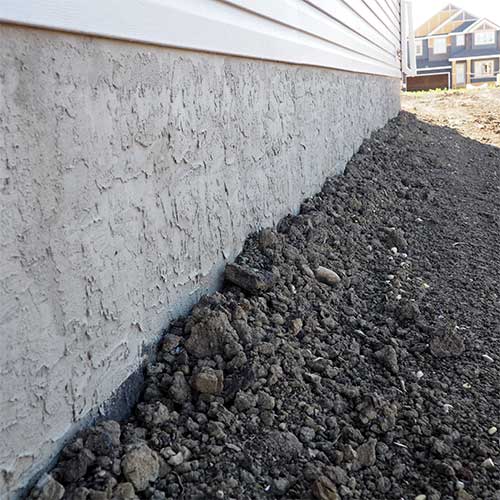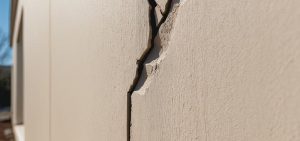Parging
This guide will explore the world of parging—a vital masonry technique used to protect and enhance your home’s walls. From what parging entails to how it’s made and applied, we aim to shed light on every aspect of this important process.
Whether you’re a seasoned Edmonton homeowner or a curious reader, this guide will help you gain a deeper understanding of parging and its role in maintaining and elevating the aesthetics of your home. So, let’s embark on this journey of discovery together.
What is Parging?
Parging is a process often used in construction to refine and safeguard walls. This technique is typically applied to the rough surface of concrete or stone walls or foundations by coating it with a thin mortar or cement mixture layer.
Parging shares similarities with stucco application but is usually used on more utilitarian, less visible surfaces like basement or foundation walls. The technique can be applied to any surface, but it’s typically used on interior and exterior above-ground basement walls.
What Does Parging Do?
Parging serves several important functions for both the aesthetics and the durability of a building in Edmonton:
-
- Protection: The primary role of parging is to provide a protective barrier for the walls of your building, particularly the foundation. This barrier shields the masonry from weathering and water damage, safeguarding your structure from wear and tear.
-
- Insulation: Parging contributes to the insulation of a building by sealing minor cracks and crevices, preventing drafts, and consequently enhancing the energy efficiency of the building.
-
- Aesthetic Enhancement: Parging can cover unsightly masonry work or damage. With the variety of textures and finishes that can be achieved, parging can significantly improve the visual appeal of a wall or a foundation.
-
- Water Resistance: While parging is not fully waterproof, it does create a water-resistant layer that helps to keep moisture away from your walls, further protecting them from potential water damage.
-
- Structural Integrity: In cases of brick or masonry deterioration, parging helps reinforce the structural integrity of the building by adding a new layer of strength to the existing walls.
-
- Preparation for Further Coating: Parging provides a smooth, clean surface, ideal for further treatments like waterproofing or painting. This not only increases the life of the wall but also enhances its aesthetic appeal.
How Is Parging Made?
Creating the perfect blend for parging is an art and a science, with a mixture of lime, water, and cement. Achieving the right balance between these components is crucial, as even minor deviations could result in an improper mix. This can lead to unwanted cracks and, even worse, issues with the parging adhering to the wall. The result? A plethora of potential structural problems, especially when faced with harsh weather conditions.
That’s why we at Depend Exteriors strongly advise homeowners to seek assistance from seasoned professionals like our team. With our expertise and knowledge, you can avoid producing an incorrect blend and save yourself from future headaches.
How Is Parging Applied?
Once we’ve concocted the perfect parging blend, it’s time to apply the mortar. We meticulously apply the parging mortar onto a damp wall using a masonry trowel.
But here’s where the beauty of parging truly shines.
You can customize the final look of your wall to be either smooth or textured, depending on your preference. This flexibility opens up a world of design possibilities, enabling you to transform spaces like your basement, living room, or recreational room into aesthetically pleasing areas.
But we don’t stop there. After the application, you can further personalize the look of the parged surface by painting over it. This allows the newly treated surface to blend seamlessly with your existing home decor, creating a cohesive and inviting environment.
Does Parging Need Maintenance?
Yes, parging does require maintenance. While it’s a durable technique that protects your home, it can begin to crack or peel over time due to exposure to natural elements and general wear and tear.
To ensure the longevity of a parged surface, regular inspections are recommended. This way, any damage or signs of wear can be identified early and addressed promptly. This usually involves repairing cracks or holes and, in some cases, applying a new coat of parging.
Regular maintenance keeps the parged surface looking good and ensures it continues to protect the masonry beneath. Maintenance requirements might vary based on your environment and the quality of the initial parging work; hence professional consultation can be beneficial.
You may also like:
What Are Some Parging Alternatives You Can Find?
In Conclusion
Parging is more than just a masonry technique; it’s a blend of science and art that enhances the aesthetics and durability of your home. It stands as a sturdy shield against nature’s harsh elements while serving as a canvas for expressing your personal style. However, creating and applying the perfect blend skillfully requires a deep understanding and years of experience in this field.
As we wrap up this guide, remember that parging is one of the best investments you can make to protect and uplift your home’s appeal. And if you’re unsure about anything or need professional parging assistance in Edmonton, Depend Exteriors is just a call away.Whether you need advice on the parging process, have questions about your home’s needs, or are ready to avail of our top-notch parging services in Edmonton, don’t hesitate to contact us.
FAQs
Parging a foundation refers to applying a thin coat of mortar to the visible surface of a foundation wall. This process enhances the appearance of the wall, provides additional protection against water infiltration, and aids in the prevention of heat loss, thereby improving energy efficiency.
Parging provides a smooth, neat finish to exterior masonry walls, enhancing their appearance. It also protects a building’s foundation against damage from external elements like rain and snow. Parging also improves your home’s energy efficiency by sealing cracks and leaks, preventing heat loss.
The main issue with parging arises when it’s not mixed or applied correctly. A bad blend or improper application can lead to cracks and issues with the parging sticking to the wall, which could lead to many structural problems, particularly in fluctuating temperatures.
Parging is made from a mixture of lime, water, and cement. The right blend of these components creates a protective and decorative mortar that can be applied to masonry walls.
The lifespan of parging can greatly vary depending on the quality of work and the weather conditions it’s exposed to. It can last between 30 to 50 years if properly maintained.
Yes, you can parge over old parging. However, it’s important to thoroughly clean and repair the existing layer before applying the new one. Any loose or damaged parts of the old parging must be removed to ensure a good bond with the new layer.
Parging can be painted over once it has properly cured. Painting your parging allows you to match it with your home’s exterior decor and provide additional protection against moisture.
While parging itself isn’t specifically waterproof, it does provide a significant degree of water resistance to your home’s foundation. It forms a barrier that helps to prevent water infiltration. However, additional measures, like applying a waterproofing membrane or coating, may be required for complete waterproofing.




